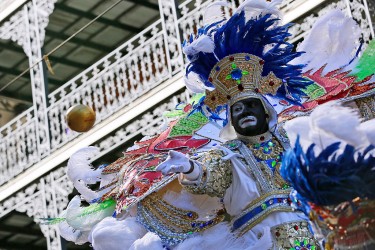In New Orleans, like in many other cities and towns, it was once a crime for men to dress as women in public. But in New Orleans, an exception was often made on one special day. During Mardi Gras, police looked the way and audiences cheered if someone cross-dressed.
Traditionally, Mardi Gras is celebrated as a time of indulgence, especially in food, drink, dancing, and pageantry. Participants revel in excess to mark the time before Ash Wednesday begins the fasting and repentance observed during the period of Lent.
In New Orleans, a historically Catholic city, Mardi Gras has also provided a rare opportunity for LGBTQ folks to freely express themselves. With costuming so key to the festivities, these celebrations created space for people to transgress many traditions, including those tied to gender norms. Over time, LGBTQ people in New Orleans subverted Mardi Gras customs to strengthen community in the face of discrimination and death.
In the mid-1800s, the elite of New Orleans, a former colonial outpost of Catholic empires, began adopting the European trend of masquerade balls and incorporating them into Mardi Gras festivities. High society men organized secretive, all-white social clubs called krewes. In 1857, the Krewe of Comus expanded their private costume ball into a public night parade, bringing the spectacle to the streets.
That same year, a city ordinance attempted to limit rowdy, masked parades by making it illegal “to appear masked or disguised in the streets, or in any public place.” While cities across the country were beginning to enact laws specifically outlawing cross-dressing, New Orleans police used its own city ordinance to regulate gender expression, even on Halloween. In other words, anti-cross-dressing laws enabled the state to surveil peoples’ gender expressions, upholding traditional gender norms by punishing “indecent” dress. But New Orleans police looked the other way during one time of the year: the pre-Lenten festivities of Mardi Gras. Thus, through the late 19th century and well into the 20th, cross-dressing during Mardi Gras posed less of a risk and was a common choice for men joining the parade-watching crowds.
Bolstered by these traditions, gay organizing around Mardi Gras gained momentum as the LGBTQ community in New Orleans grew. Nationwide, World War II introduced new same-sex spaces for people to explore their sexuality in military bases and camps. Then, the postwar economic boom allowed people to depend less on their families for financial and emotional support, which led more gay people to organize around their LGBTQ identity instead. In New Orleans specifically, Bourbon Street became an anchor for gay life, and near there, in 1949, gay men began the Fat Monday Luncheon at a popular French Quarter Restaurant.












